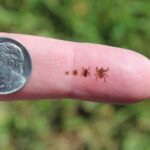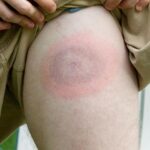Tick Smart: 5 Tips for Hikers to Prevent Tick-Borne Illness
Appalachian Trail thru-hiker and public health researcher, Emma Getz, shares advice for how A.T. hikers can avoid tick-borne illnesses on the Trail.
Read More
The greatest risk to your health and safety while hiking the Appalachian Trail is contracting a tick-borne disease.

Several species of ticks can be found in every one of the 14 states that the A.T. passes through.
Although Lyme disease, carried by the deer tick (also known as the black-legged tick), is the most common, there are several tick-borne illnesses present on the A.T. and are becoming more common, like babesiosis and anaplasmosis. Combinations of diseases may occur from a single tick bite. Although tick-borne illnesses are usually quite treatable, symptoms can be severe and long-lasting if not caught early, and a few of the less common ones can be life threatening, especially for those with compromised immune systems.
Visit the CDC’s page about ticks for comprehensive information about tick-borne illnesses.
Learn More
Get Help
The Centers for Disease Control (CDC) has an interactive Tick Bite Bot that can guide you on removing attached ticks and help you determine when to seek health care, if appropriate, after a tick bite.
Lyme disease is a bacterial infection spread by deer ticks. The characteristic “bullseye” rash sometimes occurs with Lyme disease, but not always, so it’s important to monitor your symptoms for several weeks after a bite even if a bulls-eye rash does not appear.
Lyme disease symptoms include flu-like symptoms such as fever, chills, headache, joint pain, muscle aches and fatigue. However, later symptoms of more progressed Lyme disease can be more serious, like facial paralysis, severe joint pain and swelling, and inflammation of the brain and spinal cord. Like many tick-borne illnesses, Lyme symptoms may continue for months or even years and treatment may be difficult. Treatment is most effective immediately after a tick bite.
Most humans are infected by nymphs, which are about the size of a poppy seed and difficult to see. The most common time of year to be bitten by a tick is from May through July, but you can potentially be bitten any time of year, even in cold temperatures.
Read an in-depth article about Lyme disease on the A.T.

Prevention is the best strategy! Your chances of being bitten by a tick can be greatly reduced by taking these precautions:
If you find an embedded tick, use fine-tipped tweezers or a tick key to grab it as close to the head as possible. Grasp the tick firmly and pull it out slowly and steadily. Do not yank the tick out suddenly or twist it as that can cause the tick’s mouth or head to break off and remain embedded in your skin.
Appalachian Trail thru-hiker and public health researcher, Emma Getz, shares advice for how A.T. hikers can avoid tick-borne illnesses on the Trail.
Read More

